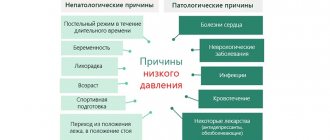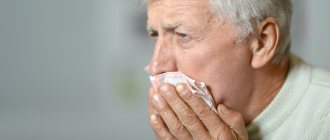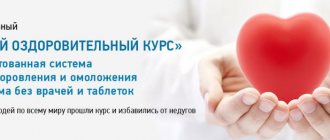Prevention of arterial hypertension
Path to page: Home For the population Prevention of diseases and healthy lifestyle Prevention of non-communicable diseases Prevention of arterial hypertensionPrevention of arterial hypertension
Arterial hypertension is defined as an increase in blood pressure above 140 and 90 mmHg. Art. If left untreated, hypertension leads to an increased risk of coronary heart disease, stroke, kidney damage, and increased overall mortality.
Hypertension, like any chronic progressive disease, is easier to prevent than to treat. Therefore, the prevention of hypertension, especially for people with a family history, is an urgent task.
First of all, everyone whose blood pressure is within the high or borderline norm should think about the prevention of hypertension, especially for young people and adolescents
Prevention of arterial hypertension can be primary and secondary.
Primary means preventing the occurrence of a disease. These prevention methods should be followed by healthy people who have a high risk of developing hypertension (heredity, work). But not only them, everyone must live in accordance with the principles of primary prevention of hypertension, because this disease often overtakes at the most unexpected moment even those who do not have unfavorable heredity and other risk factors.
Primary prevention of hypertension includes:
- Normalization of the function of the central nervous system (prevention of stress).
- A clear daily routine (constant times of getting up and going to bed).
- Outdoor exercises and physical therapy (long walks in the fresh air, cycling, moderate gardening).
- Daily loads in the gym and at home.
- Normalization of sleep (sleep up to 8 hours).
- Balanced diet. Carefully count the kilocalories consumed in food, and do not allow excessive consumption of fat. Fats can be consumed per day no more than 50–60 grams, and 2/3 of them should be fats of vegetable origin: corn, sunflower oil. Limit foods containing large amounts of animal fats - whole milk, butter, sour cream. The diet should contain a sufficient amount of proteins: low-fat fish, poultry, skim milk, cottage cheese, kefir, etc. It is necessary to limit the intake of easily digestible carbohydrates: sugar, honey, pastry products, chocolate, semolina, rice cereals.
- Weight loss (for obesity). Without weight loss, there is no need to talk about preventing hypertension. You should not try to lose weight suddenly; you can reduce body weight by 5–10% per month.
- To give up smoking!!!
- Reducing table salt consumption (consume no more than 6 grams per day).
- Consumption of foods high in potassium, calcium and magnesium salts (low-fat cottage cheese, parsley, beans, prunes, beets, baked potatoes, dried apricots, seedless raisins.)
- Limiting the consumption of alcoholic beverages.
Secondary prevention is carried out in patients in whom arterial hypertension is diagnosed. Its goal is to prevent complications from occurring. Moreover, this type of prevention includes two components: non-drug treatment of arterial hypertension and antihypertensive (drug) therapy. Non-drug treatment, in principle, corresponds to primary prevention, only with more stringent requirements. If each individual person cannot change heredity and environment, then lifestyle and nutrition can. Drug therapy is medications prescribed by a doctor that specifically act on high blood pressure, reducing it. Patients with arterial hypertension should strictly adhere to the doctor's recommendations and take medications as prescribed, thereby preventing the risk of complications.
Prevention of arterial hypertension includes systematic monitoring of blood pressure levels in the morning and evening. Consistently following the recommendations of the attending physician, promptly contacting him if the condition worsens.
Remember! It is easier (and cheaper) to prevent a disease than to treat it.
Preventing hypertension is a top priority for many people. Knowledge about measures to prevent this serious illness is especially relevant for patients with a family history and people whose blood pressure levels are within the borderline or high norm.
In this article we will tell you who is at risk for developing hypertension, as well as measures to prevent the disease.
Who is at risk
The risk group includes:
- men 35-50 years old;
- women after menopause;
- women taking estrogen-containing drugs;
- persons experiencing constant stressful situations;
- patients with cerebral atherosclerosis, cardiovascular diseases, kidney pathologies and diabetes mellitus;
- patients with high blood cholesterol levels;
- smokers;
- persons who frequently drink strong alcoholic drinks.
Hypertension deserves close and constant attention from both doctors and patients, since it can significantly worsen the quality of life and lead to the development of severe complications.
A sharp rise in blood pressure can provoke:
- severe headaches,
- significant decrease in performance,
- atherosclerosis of the arteries of the brain, kidneys and heart.
Subsequently, such disturbances in the structure and functioning of blood vessels lead to the development of hypertensive encephalopathy, aneurysms and aortic dissection, malignant hypertension, retinopathy and heart failure. However, it is possible to solve this problem with the help of constant prevention of hypertension, which involves the implementation of a number of primary and secondary measures.
Primary prevention of hypertension
Primary prevention of hypertension is indicated for all people (especially those at risk) whose blood pressure is within the acceptable range (up to 140/90 mm Hg) and the disease has not yet begun to develop.
To do this, they need to reconsider their entire habitual way of life and make the necessary amendments to it, for example, the following:
To give up smoking.
Limiting the consumption of alcoholic beverages (for men - no more than 30 ml of strong alcoholic drinks per day, for women - no more than 20 ml).
Reducing salt intake (no more than 5-6 g per day).
Rational nutrition (limiting the consumption of foods with a large amount of animal fats, no more than 50-60 g per day, and easily digestible carbohydrates).
Inclusion in the daily diet of foods rich in potassium, magnesium and calcium (dried apricots, prunes, raisins, baked potatoes, beans, parsley, low-fat cottage cheese, chicken egg yolks).
Combating physical inactivity (exercises in the fresh air and daily physical therapy exercises).
Fighting obesity (trying to lose weight dramatically is not recommended: you can reduce body weight by no more than 5-10% per month).
Normalization of sleep patterns (at least 8 hours a day).
A clear daily routine with a constant time of getting up and going to bed.
Stress prevention.
Recommendations for the primary prevention of arterial hypertension include:
timely and regular treatment of diseases of the cardiovascular, nervous, urinary and endocrine systems,
strict adherence to all doctor’s recommendations,
constant monitoring of blood pressure levels.
Persons for whom primary prevention of hypertension is indicated should be under clinical supervision.
The measures taken can lead to a stable normalization of blood pressure within 6-12 months, but when observing indicators in the border zone, they may be recommended for longer observation and taking medications, the action of which is aimed at reducing the progression of neurotic reactions (hypnotics, sedatives, bromine and phenobarbital in small doses).
Secondary prevention of hypertension
Secondary prevention of hypertension is indicated for patients in whom arterial hypertension has been diagnosed.
It is aimed at:
decreased blood pressure;
prevention of hypertensive crises;
prevention of secondary changes in organs and the development of complications.
The range of such events includes:
- non-drug treatment (more stringent measures corresponding to primary prevention);
- drug therapy.
For non-drug treatment, in addition to following the recommendations for the primary prevention of hypertension, as well as in the complex of measures, it is recommended to include:
physiotherapeutic procedures: electrosleep, electrophoresis with drugs (aminophylline, nicotinic acid, no-shpa), galvanization of the collar zone, balneotherapy (carbon dioxide, iodide-bromine and radon baths), heliotherapy, speleotherapy, hydrokinesitherapy, massage, acupuncture, laser puncture;
physical therapy;
psychotherapeutic trainings and auto-trainings;
sanatorium-resort treatment in local cardiological sanatoriums and climatic resorts (Nemirov, Mirgorod, Kislovodsk, Truskavets, Druskininkai, Sochi, etc.).
Drug therapy is prescribed to all patients with a persistent increase in blood pressure (if blood pressure remains consistently high, up to 140 mm Hg, for three months) and patients with some risks of developing cardiovascular diseases.
The selection of drugs, their dosage, regimen and duration of administration are determined individually for each patient, based on data on his state of health. The course of taking medications for hypertension should be carried out constantly and under the supervision of the attending physician.
Comprehensive measures to prevent hypertension allow you to keep arterial hypertension under constant control and significantly reduce the risk of developing various severe complications.
Source: https://doctor-cardiologist.ru/
Read also:
- How to avoid a stroke
- Pain in the heart area
- Risk factors for stroke. Everyone should know this
- Urgent self-help and mutual aid measures
- 20 facts about the human heart
- Learning to measure blood pressure correctly
- Why is hypertension dangerous?
- Stop thrombosis, save lives
- WHO. Prevention of heart attacks and strokes
- How to recognize a stroke in time
- Hypertension is an epidemic of the 21st century. Questions and answers
- Sick heart: hidden signs
- Arterial hypertension - basic concepts
- World Hypertension Day
- September 29 – World Heart Day
- Want a healthy heart? Move more!
- VTsIOM: about a third of Russians lead a lifestyle that contributes to the development of stroke
- A third of Russians over 18 are at risk for stroke
- WHO. Global recommendations on physical activity for health
- Stroke. The diagnosis will be made by a doctor
- Stroke. The result is worth the effort
- Cholesterol: what is it?
- How to prevent cardiovascular accident
- Doctors have identified the main cause of death in Crimea
Stepnovskaya district hospital
Hypertension is a disease in which blood pressure (BP) increases constantly or at regular intervals. Prevention of hypertension will help to avoid the appearance of hypertension and crises, exacerbations of the disease, and will also improve the general condition.
In order to avoid serious illness, especially for older people, you need to monitor your health and promptly seek qualified medical help, take medications recommended by your doctor to prevent the disease, and also do exercises to prevent hypertension.
What is hypertension and types of its prevention
For an adult, the norm is considered to be when blood pressure is 120/80 mmHg. But there are people who feel great with low blood pressure - 100/70 mm Hg. or elevated – 140/110 mm Hg. and for them this is considered the norm. Only this is a rare exception, but for many people it is a significant pathology. The first indicator shows the number of contractions of the heart walls and is called systolic pressure. The second indicator, diastolic pressure, shows the amount of relaxation of the heart walls. Doctors advise regularly measuring blood pressure to diagnose the disease at an early stage.
The following symptoms may lead to suspicion of hypertension:
- Constant headaches, namely in the temporal and occipital parts.
- Red complexion.
- Numbness of fingers, coldness in extremities.
- Decreased memory, performance, poor attention.
- Deterioration of vision, spots appear in the eyes.
- Shortness of breath resulting from slight physical labor.
- Dizziness and tinnitus.
- Increased feeling of fear, anxiety.
- Profuse sweating, chills;
- Swelling of the face.
This disease is very common nowadays. It is most common in women after menopause, as well as in men over 60 years old. Hypertension used to be most common in older people, but today it affects both children and adolescents. Juvenile hypertension occurs in 18% of the world's young population. The reason for its occurrence at this age is heredity.
This disease is very dangerous because elevated blood pressure sometimes leads to death. If not treated in time, complications are possible, such as disturbances in the functioning of the brain, kidneys and heart.
Prevention of the disease is divided into primary and secondary. Primary prevention is preventing the occurrence of disease. Secondary prevention is a set of measures for people with a confirmed diagnosis. Primary and secondary prevention of hypertension is very important.
Primary prevention
It is aimed at eliminating possible risks and eliminating the causes of hypertension. Most of the time, the actual cause of the disease is unknown, so lifestyle changes will be required.
- Physical exercise. They must correspond to the age and characteristics of the body. Other medical conditions must also be taken into account. Long walks in the fresh air, as well as swimming, running, and cycling will have a beneficial effect.
- Reduce salt intake. It is recommended to consume no more than 6 grams of salt per day, and also take into account its content in some products, such as sausage, cheese, and canned food. It is necessary to add herbs, garlic to food, and also consume salt with a low sodium content. Be sure to add to the menu foods high in calcium, potassium and magnesium (cottage cheese, prunes, raisins, potatoes, dried apricots, beets).
- Increase the amount of vegetable fats, and, on the contrary, reduce the amount of animal fats. Consume foods such as sour cream, lard, full-fat milk, butter, and sausage as little as possible. The diet should contain more lean fish, sunflower oil, fruits and vegetables. Every day you need to consume dairy products, always low-fat cottage cheese and kefir.
- In order to prevent and treat hypertension, it is necessary to reduce psychological stress. It is imperative to avoid stressful situations, try to solve problems that arise calmly, so as not to harm the nervous system, and, therefore, avoid complications in the form of cardiovascular diseases. Noise stimuli in everyday life lead to an increase in blood pressure, for example, watching TV shows at high volume, as well as ambient noise in large cities (noise emitted by factory equipment, close proximity to railways, highways, airports).
- Complete cessation of bad habits (alcohol, smoking).
Secondary prevention
It includes the use of drugs and non-drug treatments, and also slows the onset of attacks. Non-drug treatment is a change in the usual lifestyle, but much stricter than with previous prevention. In the secondary prevention of hypertension, lifestyle changes are not a recommendation, but a mandatory requirement for full recovery. Here, it is also mandatory to take medications that lower blood pressure.
It is necessary to adhere to diet, sleep, and exercise. Drug treatment is based on long-term systematic medications, but when taking them, it is necessary to keep in mind that it is advisable to lower blood pressure gradually, especially for older people and those who have heart disease.
A mandatory condition related to secondary prevention measures is daily blood pressure measurement.
Reminder for patients with hypertension
A short list of rules for maintaining health:
- measure blood pressure daily;
- Healthy food;
- perform physical activity;
- eliminate bad habits;
- learn to behave calmly in stressful situations;
- follow the doctor's recommendations.
Exercises to prevent illness
Physical therapy plays a special role in the prevention of hypertension. It strengthens the body, stabilizes the functioning of the nervous and cardiovascular systems, and improves metabolism. Properly performed exercises keep blood vessels toned.
Classes must be conducted regularly and must be age appropriate. Basically, people with high blood pressure are prohibited from the following exercises:
- rhythmic, sharp exercises;
- lifting weights;
- exercises that involve lowering your head down;
- lifting very heavy things;
- conducting physical therapy at very high or, conversely, low temperatures, as well as in an unventilated room.
In conclusion, we can briefly say about the prevention of hypertension that you need to adhere to all of the above recommendations, as well as follow all the advice of your doctor. You cannot interrupt the prescribed treatment on your own, or do not finish the recommended courses of medications if your health has improved slightly. After all, by adhering to preventive measures, you can protect your life and reduce the risk of stroke.
What is hypertension?
The word hypertension is used to refer to persistently elevated blood pressure. An increase in blood pressure occurs when there is a narrowing of the arteries and/or their smaller branches, the arterioles. Arteries are the main transport routes through which blood is delivered to all tissues of the body. In some people, the arterioles often narrow, initially due to spasm, and later their lumen remains permanently narrowed due to wall thickening. And then, in order for the blood flow to overcome these constrictions, the work of the heart increases, more blood is released into the vascular bed. Hypertension develops. Very rarely, in approximately one in ten patients, the cause of increased blood pressure is damage to an organ. In these cases we talk about secondary or symptomatic hypertension. In the vast majority of cases, approximately 90% of patients, we are talking about so-called primary, or essential hypertension. Despite the fact that the cause of high blood pressure in these patients has not yet been fully established, there is no doubt that untreated hypertension is a serious threat to their health. The most common complications of hypertension are damage to vital organs such as the heart, brain and kidneys. The main symptom of arterial hypertension is high blood pressure (above 160/95 mm Hg), which may be accompanied by headache, dizziness, flashing before the eyes of spots, spots, circles, and decreased visual acuity. Pain in the heart area, a feeling of palpitations and interruptions in the functioning of the heart are possible. During an increase in pressure, a feeling of heat may occur, the face and other areas of the skin turn red, and then sweat appears on them. The limbs, on the contrary, tend to get cold. In later stages of the disease, symptoms of circulatory failure appear: blueness of the tip of the nose, fingers (acrocyanosis), swelling, shortness of breath during exercise, and eventually at rest. Other symptoms of arterial hypertension do not go unnoticed by the doctor: an increase in the size of the heart, a change in its tones when listening. As the disease progresses, signs of brain and kidney damage appear.
State budgetary healthcare institution "City Hospital" of Gaya
Memo for the population
Arterial hypertension (hypertension, hypertension ) is one of the most common diseases of our time, which leads to the development of cardiovascular diseases.
It is impossible to completely cure this disease, but blood pressure can be kept under control. The earlier you identify arterial hypertension and begin to monitor it over time, the lower the risk of developing complications of hypertension in the future.
Factors that increase the risk of developing arterial hypertension:
- Age (the older the person, the higher the likelihood of increased blood pressure).
- Hereditary predisposition (AH in first-degree relatives - (father, mother, grandparents, siblings)
- Gender (After menopause, the risk increases significantly in women).
- Smoking (components of tobacco smoke, entering the blood, cause vasospasm, which leads to increased blood pressure).
- Excessive alcohol consumption
- Excessive exposure to stress (the stress hormone adrenaline causes the heart to beat, pumping a large volume of blood per unit of time, as a result of which blood pressure rises).
- Atherosclerosis (excess cholesterol leads to loss of elasticity in the arteries, and atherosclerotic plaques narrow the lumen of blood vessels, which makes it difficult for the heart to function. All this leads to increased blood pressure).
- Excessive salt consumption (Excess salt in the body often leads to arterial spasm, fluid retention in the body and, as a result, to the development of hypertension).
- Obesity (overweight people have higher blood pressure than thin people). It is estimated that every kilogram of excess weight means an increase in blood pressure by 2 mmHg).
- Insufficient physical activity (people who lead a sedentary lifestyle are at risk of developing hypertension).
PREVENTION OF ARTERIAL HYPERTENSION:
Prevention of arterial hypertension is divided into primary and secondary
Primary prevention
Primary prevention is measures to prevent the development of hypertension; they are intended for healthy people, but those at risk. Such prevention includes:
- gymnastics, moderate physical activity (walking, swimming);
- the amount of salt in the diet is reduced to a minimum, and also reduce as much as possible the consumption of foods such as cheeses, canned food, smoked foods, mayonnaise, etc.;
- removing fried foods, lard, sausages, butter, fatty meat from the diet, replacing them with low-fat fish, dietary meat, vegetables, fruits;
- eliminating stressful situations, organizing proper rest and sleep;
- refusal of alcoholic drinks, smoking;
- control of weight, blood cholesterol, blood pressure.
Secondary prevention
Secondary prevention measures are intended for patients diagnosed with hypertension; they are aimed at reducing the negative impact of the disease on target organs, preventing complications such as stroke, ischemia and others.
Secondary prevention is:
- non-drug therapy (lifestyle changes, proper nutrition, exercise, proper rest);
- drug therapy prescribed for life (mono-, combination therapy prescribed by a doctor based on many factors).
- the prescribed treatment regimen is followed exactly; doses cannot be changed or days taken;
- all medications should be taken only at the same time, without disrupting the regimen;
- you cannot stop taking medications if your blood pressure level is normal;
- You should always have some supply of medications with you, you need to replenish it before it runs out;
- You cannot arbitrarily replace medications with others or use only traditional medicine, unless recommended by a doctor.
Attention: when taking medications, you should not sharply reduce blood pressure levels, as this leads to ischemia!
Remember that in the first 2 hours of assistance, blood pressure should decrease by no more than 20 percent from the initial level.
Goryachkina A.S. – head floor. No. 1.
Hypertension: causes and prevention
Hypertension is characterized by increased blood pressure in the arteries compared to normal. In a healthy person, normal blood pressure is approximately 120/80 mmHg. Some people have low blood pressure (100/70) or high blood pressure (over 140/90). The upper pressure reading (systolic pressure) corresponds to the contraction of the heart walls, the lower reading (diastolic pressure) corresponds to the relaxation of the heart walls. Risk of hypertension
Hypertension today is a widespread disease that is typical for residents of highly developed countries.
In Russia, hypertension occurs in every third person. In addition, at present, this disease is rapidly becoming younger, and today hypertension can be found in adolescents. The main danger of hypertension is that high blood pressure can cause ruptures of blood vessels in the heart, brain, eyes, kidneys, and lead to premature death. Untreated hypertension shortens life. Symptoms of high blood pressure:
headache;
dizziness. the appearance of “flies” before the eyes; noise in ears; pain in the heart area; strong heartbeat In some cases, hypertension is asymptomatic. This disease is called the “silent killer.” Physical causes
At the physical level, the development of hypertension is caused by a reduction in the lumen of blood vessels due to atherosclerosis.
Due to the narrowing of blood vessels, blood flow is impeded. In order to push blood through the narrowed bloodstream, the heart makes more effort. At the same time, blood pressure on the walls of blood vessels increases, which causes an increase in blood pressure. Psychosomatic causes
Hypertension is a psychosomatic disease.
Blood pressure reflects the degree and nature of a person’s activity, his attitude to various events, and to obstacles along the path of life. Increased blood pressure is a person’s reaction to certain events in life. Those people who have been experiencing internal tension and resistance for a long time, generated by all kinds of fears, mistrust, and unwillingness to accept a particular situation, increase their blood pressure. A person experiences pressure from troubles that he cannot cope with at the moment. Thus, the psychological cause of hypertension is a person’s tendency to dramatize a situation: to worry about past events and worry about future affairs. Such a person wants those around him to be happy and takes on too much responsibility. Thus, he puts strong pressure on himself, which leads to an increase in internal tension and an increase in blood pressure. Treatment of hypertension
Treatment of psychosomatic diseases should be carried out comprehensively: both at the physical and psychological levels.
It is important not only to get rid of high blood pressure as a consequence of the disease, but also to eliminate the cause of its occurrence. And the reasons are most often emotional. Drug treatment
In the drug treatment of hypertension, several groups of drugs are used: drugs to lower blood pressure (there are 5 groups of such drugs);
vasodilators; sedatives. The selection of medications is strictly individual for each patient and is carried out by the attending physician based on an analysis of the patient’s condition, symptoms of the disease and developed complications of hypertension. Treatment with folk remedies
In addition to drug treatment, you can use folk remedies.
Herbal medicine (herbal treatment) can be of great help. Mostly sedative herbs are used, which have a calming effect. These include hawthorn, valerian, chamomile, peppermint, and lemon balm. Honey, citrus fruits, rose hips and green tea are used to reduce blood pressure. For people with hypertension, special diets are selected that involve reducing salt in food and reducing fluid intake. People with hypertension are prohibited from drinking alcohol. Psychological treatment
For a person with high blood pressure, it is advisable to give up the pursuit of the approval of others, and learn to live simply and love people.
The authors of books on self-healing suggest using the following positive attitudes: “I am calm and healthy,” “There is peace in my soul,” “I am in harmony with life.” Prevention of hypertension Hypertension
cannot be prevented by a one-time vaccination or a one-time preventive measure.
In order to prevent the development of hypertension, it is necessary to constantly maintain a healthy lifestyle and a balanced diet. Tips for preserving and maintaining health:
Exercise regularly to keep blood vessels in good shape. Maintain a normal weight, since obesity can lead not only to hypertension, but also to coronary heart disease. Stop smoking, as nicotine constricts blood vessels. After hard work, mandatory rest is necessary. At the same time, active rest is recommended for mental workers, and for people whose work involves physical activity, rest in a quiet environment is suitable. Take blood tests for sugar and blood lipids (cholesterol, triglycerides) twice a year. Measure your blood pressure regularly. Periodically undergo an ECG of the heart. Remember that preventive measures, as well as timely and correct diagnosis, will prevent the development of a serious disease.
Deputy Chief Physician for Medical Affairs
OGAUZ "Angarsk City Hospital No. 1"
Protasova V.A.
Section: Diseases of the cardiovascular system







